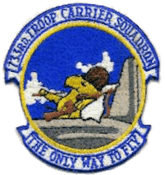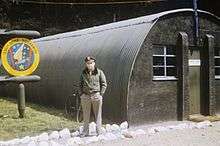733d Military Airlift Squadron
733d Military Airlift Squadron
 | |
|---|---|
_during_Vietnam_War.jpg) Air Force Reserve C-124 Globemaster | |
| Active | 1942–1945; 1947–1951; 1952–1955; 1957–1973 |
| Country | United States |
| Branch |
|
| Role | Airlift |
| Part of | Air Force Reserve |
| Motto(s) | The Only Way to Fly |
| Engagements | European Theater of Operations |
| Decorations | Distinguished Unit Citation |
| Insignia | |
| Patch with 733d Troop Carrier Squadron emblem (approved 22 April 1960)[1] |
 |
| Unofficial 333d Bombardment Squadron emblem[2] |
 |
| World War II Fuselage code[2] | TS |
The 733d Military Airlift Squadron is an inactive United States Air Force unit. It was last assigned to the 945th Military Airlift Group. It was inactivated at Hill Air Force Base, Utah on 1 January 1973.
History

Activated as a B-17 Flying Fortress heavy bomb squadron; trained under Second Air Force. Completed training in early 1943; deploying to European Theater of Operations (ETO) assigned to VIII Bomber Command in England. Engaged in long-range strategic bombardment operations over Occupied Europe and Nazi Germany, March 1944 – May 1945 attacking enemy military and industrial targets as part of the United States' air offensive against Nazi Germany. Most personnel demobilized in Europe after the German capitulation in May 1945; squadron inactivated as a paper unit in November.
Reactivated in 1947 as a B-29 Superfortress squadron in the reserves, however equipped with trainers until 1949 when equipped with B-26 Invader light bomber. Squadron activated in 1951 as a result of the Korean War; personnel and equipment assigned as replacements to units of Far East Air Forces, then inactivated as a paper unit.
Reactivated in the reserves as a C-119 Flying Boxcar squadron in 1952; Activated during Cuban Missile Crisis in 1962; returned to reserve status after crisis was resolved. Equipped with C-124 Globemaster II strategic transports and performed strategic airlift until inactivated in 1973 with the final phaseout of the C-124.
Lineage
- Constituted as 333d Bombardment Squadron (Heavy) on 28 January 1942
- Activated on 15 June 1942
- Inactivated on 1 December 1945
- Redesignated 333d Bombardment Squadron (Very Heavy) on 13 May 1947
- Activated in the reserve on 29 May 1947
- Redesignated 333d Bombardment Squadron (Light) on 26 June 1949
- Ordered to active service on 10 March 1951
- Inactivated on 20 March 1951
- Redesignated 333d Tactical Reconnaissance Squadron on 26 May 1952
- Activated in the reserve on 14 June 1952
- Inactivated on 18 May 1955
- Redesignated 733d Troop Carrier Squadron (Medium) on 24 October 1957
- Activated in the reserve on 16 November 1957
- Ordered to active service on 28 October 1962
- Relieved from active duty on 28 November 1962
- Redesignated 733d Military Airlift Squadron (Associate) on 1 January 1966
- Inactivated on 1 January 1973
Assignments
- 94th Bombardment Group, 15 June 1942 – 1 December 1945; 29 May 1947 – 20 March 1951
- 94th Tactical Reconnaissance Group, 14 June 1952 – 18 May 1955
- 452d Troop Carrier Group, 16 November 1957
- 452d Troop Carrier Wing, 14 April 1959
- 349th Troop Carrier Wing, 28 October 1962
- 452nd Troop Carrier Wing, 28 November 1962
- 945th Troop Carrier (later Military Airlift) Group, 17 January 1963 – 1 January 1973
Stations
|
|
Aircraft
- B-17 Flying Fortress, 1942–1945
- C-119 Flying Boxcar, 1952–1965
- C-124 Globemaster II, 1965–1973
References
Notes
- ↑ This image depicts another squadron emblem. This version was apparently used earlier, but neither version received official approval. Watkens, pp. 40–41.
Citations
Bibliography
![]()
- Maurer, Maurer, ed. (1982) [1969]. Combat Squadrons of the Air Force, World War II (PDF) (reprint ed.). Washington, DC: Office of Air Force History. ISBN 0-405-12194-6. LCCN 70605402. OCLC 72556.
- Watkins, Robert (2008). Battle Colors: Insignia and Markings of the Eighth Air Force In World War II. Vol I (VIII) Bomber Command. Atglen, PA: Shiffer Publishing Ltd. ISBN 0-7643-1987-6.